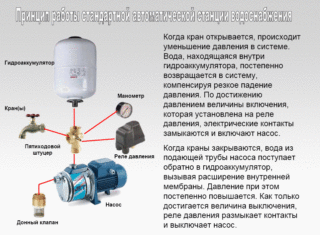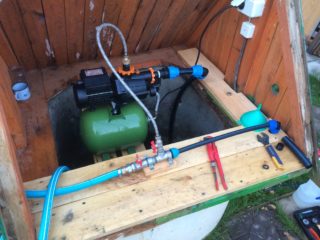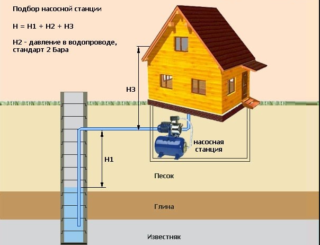Silent water pumping stations for a private house do not create discomfort for a person and have excellent performance. With the help of such equipment, you can achieve uninterrupted water supply in a suburban area, ensuring the transportation of water from a well or well.
The device and principle of operation of the pumping unit

- The hydraulic accumulator is one of the main parts of the pump. Prevents the occurrence of water hammer in the event of the first water supply to the tank.
- Surface pump. With its help, water is taken from the well.
- Electrical engine. The structure is connected by means of an electric wire with a pressure switch.
- A monometer is a tool for monitoring the pressure of a pumping station.
- Pressure switch. It has an automatic setting, spontaneously starts when the pressure in the tank drops, and turns off when it reaches the required limit.
The accumulator usually comes with a tank of different sizes. Mostly 50-500 liters. The operating time also changes depending on the size of the water tank. It will take 30-40 minutes for the station to fill the 200 l tank. After the tank is completely filled, the motor is idle.
The principle of operation of the installation is based on several stages:
- When the structure is connected to the mains and the operating mode is started, the pump starts pumping water into the system. First of all, the tank that comes with the kit is filled.
- When the pressure in the tank reaches 2.5 atmospheres, the pump turns off and remains in this state until the tap on the water supply is opened.
- As soon as the pressure in the tank has dropped to 1.5 atmospheres, the pressure switch starts the pump and the filling of the tank continues.
- After closing the drain valve, the pump runs until the accumulator is completely filled.
As a result, the pumping station comes into standby mode until the next water discharge.
Criteria for choosing silent pumping stations for a private house
- Noise level is an important parameter for devices that are installed on the territory of a residential building. Its indicator should be no more than 30-45 dB.
- Unit power. This indicator is taken into account without fail depending on the area of the house, which must be fully serviced by the pumping structure.
- Well characteristics. Depth, diameter, static water level and other parameters should be taken into account when choosing a pump for your home.
The strength and reliability of the case, as well as the integrity of the electrical cable are equally important factors that must be taken into account when buying a household pumping station.
Installation features

A low-noise pumping station requires careful and experienced installation. At this stage, it is important to correctly connect all the components and ultimately be sure to check the performance of the structure. To carry out the installation, you must follow the instructions.
- Having decided on the location of the structure, it is necessary to correctly position the station so that the outlet and inlet of the inlet and outlet openings are directed towards the pipeline.
- It is necessary to fix the structure on a special bracket, while the unit should not come into contact with the wall. On the supports that hold the fasteners, you need to put spacers.
- The entrance to the station is equipped with a special adapter. It is fixed to the incoming end of the pipe coming out of the trench. Next, the pipe is connected to the valve.
- The output of the pumping station is organized as follows: a pressure switch and a hydraulic accumulator are switched by means of a hose of the appropriate diameter.
- Fine filters are connected to the relay using pipes, a stationary water supply pipe comes to the filter outlet, which leads to the house.
- The pipe in the well shaft is locked with a special shutter. This is done so that the water collected by the pump does not drain back.
- Be sure to put on a mesh filter on the end of the pipe, which is in the well. It will prevent silt and earth from entering the water supply system.
The quiet pumping station has special insulation that suppresses most of the vibrations given off by the pump. Therefore, such a unit can be placed in a basement or on a basement floor.
Advantages and disadvantages
Any equipment, including domestic pumps, has a number of advantages and disadvantages. They need to be studied even at the stage of choosing a device. Benefits:
- independence from the main water supply;
- the possibility of using a clean source without chlorine and other chemical elements;
- the device is distinguished by its reliability and high performance.
Among the shortcomings, it is necessary to highlight the intolerance of the pumping station to fine sand. If particles get into the motor, it may be damaged.









